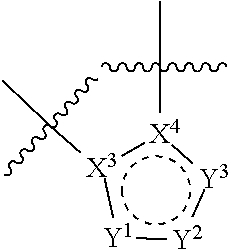Ferroportin inhibitors and methods of use
a technology of ferroportin and inhibitors, which is applied in the field of ferroportin inhibitor compounds, can solve the problems of unfavorable treatment of patients, removal of chelated iron, and many diseases, and achieve the effects of increasing iron absorption, iron overload, and increasing iron levels
- Summary
- Abstract
- Description
- Claims
- Application Information
AI Technical Summary
Benefits of technology
Problems solved by technology
Method used
Image
Examples
example 1.1
Method A: General Synthetic Method for Nucleophilic Coupling of Amine to Bicyclic Intermediates
[0185]Amine coupling procedure-1: Into a round-bottom flask purged and maintained with an inert atmosphere of nitrogen, was placed a solution of bicyclic intermediate 2a (X═Cl) (1.0 equiv) in aprotic solvent such as dimethylformamide (DMF) or acetonitrile (MeCN), amine (1.1 to 2 equiv), base such as K2CO3 (2.0-4.0 equiv). The resulting solution was stirred for 0.5 hr to 24 hr at a heated temperature between 45 to 125° C., cooled down and the solids were filtered out. The resulting solution was diluted with H2O. The resulting solution was extracted with ethyl acetate and the organic layers combined and dried over anhydrous sodium sulfate and concentrated. The residue was purified by chromatography on silica gel column to give the desired intermediate 3a.
[0186]Amine coupling procedure-2 (via N-oxide as intermediate): Into a round-bottom flask, was placed bicyclic intermediate 2a (X═H) (1 equ...
example 1.2
Method B: General Synthetic Method for Amine Protection Group Removal
[0188]Procedure-1: Into a round-bottom flask, was placed benzyloxycarbonyl-bicyclic intermediate 3a (Y=benzyloxycarbonyl) (1.0 equiv), HBr in acetic acid (AcOH) (40%) (5 to 25 mL). The resulting solution was stirred for 0.5 hr to 12 hr at room temperature and diluted with 50 mL of H2O. The resulting solution was extracted with ethyl acetate and the aqueous layers combined. The pH value of the solution was adjusted to 12 with NaOH (10%). The resulting solution was extracted with ethyl acetate and the organic layers combined and dried over anhydrous sodium sulfate and concentrated. The residue was purified by chromatography on silica gel column or preparative HPLC to give the amine 4a.
[0189]Procedure-2: Into a round-bottom flask, was placed tert-butyloxycarbonyl protected bicyclic intermediate 3a (Y=t-butyloxycarbonyl) (1 equiv). This was followed by the addition of HCl in ethyl acetate (EtOAc) dropwise with stirring...
example 1.3
Method C: General Synthetic Method for Michael Addition
[0190]Into a round-bottom flask, was placed bicyclic alkylamine 4a (1.0 equiv), N-(2-nitrophenyl)prop-2-enamide 5a (1.0 to 1.8 equiv), tosylic acid (TsOH) (0.2 to 1.0 equiv), and acetonitrile (AcCN). The resulting solution was stirred for 0.5 to 24 hr at 25 to 65° C. (e.g., 40° C.), cooled down and concentrated. The resulting solution was diluted with 20 mL of H2O. The resulting solution was extracted with ethyl acetate and the organic layers combined and dried over anhydrous sodium sulfate and concentrated. The residue was purified by chromatography on silica gel column to give Michael addition adduct 6a.
PUM
 Login to View More
Login to View More Abstract
Description
Claims
Application Information
 Login to View More
Login to View More - R&D Engineer
- R&D Manager
- IP Professional
- Industry Leading Data Capabilities
- Powerful AI technology
- Patent DNA Extraction
Browse by: Latest US Patents, China's latest patents, Technical Efficacy Thesaurus, Application Domain, Technology Topic, Popular Technical Reports.
© 2024 PatSnap. All rights reserved.Legal|Privacy policy|Modern Slavery Act Transparency Statement|Sitemap|About US| Contact US: help@patsnap.com










